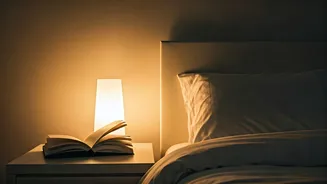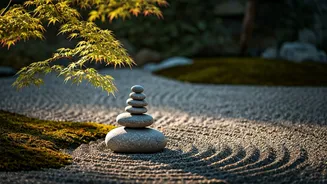What is Dark Showering?
The term 'dark showering' refers to a practice where individuals reduce or eliminate the use of artificial light while showering. Instead of bright overhead
lights, practitioners may opt for showering in near darkness, possibly using only natural light if available or a very dim light source. The core concept behind dark showering is to minimize sensory stimulation and create a more tranquil environment, thereby potentially helping to alleviate stress and improve sleep quality. Some proponents suggest it mimics the natural darkness of nighttime, which may promote the body's production of melatonin, a hormone crucial for regulating sleep cycles. By removing the harshness of bright lights, the practice seeks to foster a more introspective and calming experience, encouraging a deeper connection with the body and senses during the bathing ritual.
Stress Reduction Benefits
One of the primary benefits associated with dark showering is its potential to reduce stress levels. The absence of bright lights can create a more serene and peaceful environment, allowing the mind and body to relax. The sensory deprivation of a darker space can lessen the overload of external stimuli, offering a sense of calm. This can be especially useful for individuals who lead busy lives, providing a brief respite from the constant barrage of information and demands. Furthermore, the quiet and dimly lit setting of dark showering can facilitate mindfulness, encouraging people to concentrate on the present moment and body sensations. This mindful approach can decrease the production of cortisol, the primary stress hormone, leading to a sense of relaxation and decreased anxiety. The practice allows for a deeper connection with oneself, promoting mental stillness and helping to combat the pervasive feeling of being overwhelmed.
Improved Sleep Quality
The practice of dark showering may also contribute to better sleep quality. By eliminating the strong light exposure, it can promote the body's natural production of melatonin. Melatonin is a hormone that regulates the sleep-wake cycle, and darkness signals to the brain that it's time to sleep. Consistent bright light exposure, particularly before bed, can suppress melatonin production, making it difficult to fall asleep. By creating a dark showering environment, one essentially conditions the body to connect the bathing ritual with an impending period of rest. Dark showering can then become a cue for the body to start producing melatonin, preparing the individual for a restful night's sleep. This gentle transition from light to dark helps to synchronize the body's circadian rhythm, making it easier to fall asleep and stay asleep throughout the night. It contributes to deeper and more restorative sleep, which is essential for overall health and well-being.
Enhancing Mental Well-being
Dark showering may also have significant benefits for mental health. The calming environment can provide a space for introspection and reflection. In the absence of bright lights and visual stimuli, thoughts and emotions may surface more easily, offering the opportunity for processing and self-awareness. This can be particularly beneficial for people who have anxiety or are dealing with emotional challenges. The sensory deprivation can reduce overstimulation, allowing the mind to quiet down. Many practitioners report a heightened sense of connection with their body during dark showers, increasing mindfulness and a greater appreciation for the present moment. This sense of presence and self-awareness can lead to a more positive self-perception, reduced feelings of anxiety, and an overall improvement in mental well-being. It serves as a simple yet effective tool for practicing self-care and fostering a positive relationship with one's own mind and body.
How to Practice
Implementing dark showering is quite simple. Begin by turning off the bathroom lights before your shower. If any natural light is available, utilize it, though it's still possible to practice during the evening or in the absence of sunlight. Some people use a dim night light or a candle. The aim is to create a softly lit environment rather than complete darkness, ensuring safety and ease of movement. Be mindful of potential hazards like slippery surfaces. Prior to entering, prepare the shower by ensuring that soap, shampoo, and other bathing essentials are within easy reach. While showering, concentrate on the sensations of the water and the fragrance of the products. Practice deep breathing to further enhance relaxation and mindfulness. After the shower, move slowly, allowing your body to adjust to the transition. Consider extending the calming experience by using a soft towel and engaging in a gentle skincare routine in the dim lighting. Consistency in this practice can help you reap its benefits.
Potential Considerations
While dark showering provides several benefits, it's also important to be aware of potential considerations. Safety is paramount; be very careful to avoid slips and falls, especially in the absence of light. Ensure that any lights are placed securely and won't present a fire hazard. People with certain medical conditions, such as those that might make them more prone to balance issues, should exercise extra caution. If you're using candles, be very mindful of their placement, keeping them away from flammable materials and out of reach. It may take some time to become accustomed to the practice, particularly if one is used to bright lights. Start slowly, gradually reducing the light intensity to find the level that best suits your comfort. It is also good to assess your bathroom environment. If the shower area is small or poorly ventilated, the use of a candle might create a problem. Always prioritize safety and listen to your body and adjust as needed. If you experience any negative reactions, discontinue the practice and consult with a healthcare professional.












